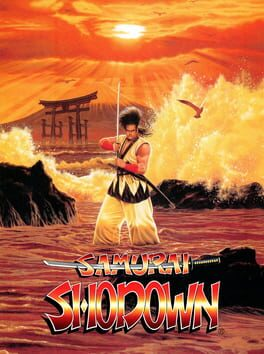▲
1
▼
The Sega CD version of the game contains a hidden message:
"r en rar politik!
Carl-Henrik 1995
JVC SUXX!!!!"
"Carl-Henrik" is programmer Carl-Henrik Skarstedt. The message implies that he was not happy with the ports publisher, JVC.
"r en rar politik!
Carl-Henrik 1995
JVC SUXX!!!!"
"Carl-Henrik" is programmer Carl-Henrik Skarstedt. The message implies that he was not happy with the ports publisher, JVC.
▲
1
▼
Adachi was originally going to make another ninja character that was very similar to Hanzo Hattori's design. However, because his wife was a fan of the 1987 manga Animal Doctor, he wanted to make a character that would be popular with the female market. Galford's character was inspired by the main character, Masaki Nishine, and his pet Siberian Husky, Chobi.
▲
1
▼
The idea for the Ikari gauge (renamed the POW bar in the Western release) was inspired by a Street Fighter II match that background designer Tomoki Fukui had with series creator Yasushi Adachi.
"Adachi came up with the idea, but the inspiration for the Ikari gauge came when the dev team was all playing Street Fighter 2 together for research purposes. Adachi and I were playing against each other and I frustrated him because I won. Adachi was so mad because he lost that he was silent for a minute. Then, he suddenly got up and shouted “Ikari gauge!” So we took that frustration, that anger and rage that players feel when they lose a battle, and decided to incorporate it into the game. That was where the inspiration for the Ikari gauge came from."
"Adachi came up with the idea, but the inspiration for the Ikari gauge came when the dev team was all playing Street Fighter 2 together for research purposes. Adachi and I were playing against each other and I frustrated him because I won. Adachi was so mad because he lost that he was silent for a minute. Then, he suddenly got up and shouted “Ikari gauge!” So we took that frustration, that anger and rage that players feel when they lose a battle, and decided to incorporate it into the game. That was where the inspiration for the Ikari gauge came from."
▲
1
▼
The game was designed to illustrate the terror of fighting weapon-to-weapon and the impact of fighting with a sword. Thus, being hit by a weapon does significant damage to the opposing player. This punishing difficulty faced criticism during the game's development. As noted by series creator Yasushi Adachi:
"There was a lot of internal criticism about deducting so much life gauge with one attack. SNK management said this design had to be changed, but I thought it was very interesting to have players fight under the risk and fear of fighting with weapons and feel the destructive force of the sword, so I ignored them and kept it in the game."
"There was a lot of internal criticism about deducting so much life gauge with one attack. SNK management said this design had to be changed, but I thought it was very interesting to have players fight under the risk and fear of fighting with weapons and feel the destructive force of the sword, so I ignored them and kept it in the game."
▲
1
▼
Gen-An's character was inspired by Johnny Depp's titular character from the Tim Burton film Edward Scissorhands. When asked why Gen-An became a green, hunchbacked character instead of more resembling Depp, series creator Yasushi Adachi replied: "I think you’ll agree with me on this, but Genan is more handsome than Johnny Depp. [Laughs]"
▲
1
▼
According to Yasushi Adachi, the original idea for the game was a side-scrolling action game with various monsters. When considering what would appeal to a global audience while creating the concept for a monster game, he "ultimately felt that a fighting game with ninjas and samurais, which represented distinctly Japanese characters, would do better than just monsters", and changed the concept accordingly. Gen-An Shiranui is the only surviving character from the initial concept.
▲
1
▼
Mai Shiranui from Fatal Fury makes a cameo appearance in Gen-An's ending as his final opponent Spoiler:to which Gen-An immediately dies from one blow.
▲
1
▼
Haohmaru and Ukyo are based on historical figures Musashi Miyamoto and Kojiro Sasaki from Sengoku era Japan, respectively. Nicotine is likely based on the Buddhist monk Takuan from the same era.
Related Games
Samurai Shodown 64
Samurai Shodown
Samurai Shodown II
Samurai Shodown III
Samurai Shodown Anthology
Capcom vs. SNK 2: Mark of the Millennium 2001
SNK vs. Capcom: SVC Chaos
Capcom vs. SNK: Millennium Fight 2000
Donkey Kong Country
The Smurfs
The House of the Dead
Mario Paint
The King of Fighters XIV
Champions World Class Soccer
Caveman Ninja
Rise of the Tomb Raider
Mickey Mania: The Timeless Adventures of Mickey Mouse
Sonic & Sega All-Stars Racing
Back to the Future Part III
Castle of Illusion Starring Mickey Mouse
Phantasy Star IV: The End of the Millennium
Shaq-Fu
Sonic 3D Blast
Sonic the Hedgehog 4: Episode I
Pac-Man Championship Edition
The Lion King
Yakuza 0
Twinkle Star Sprites
Sonic Adventure 2: Battle
Barkley: Shut Up and Jam!
Super Monkey Ball
The Legend of Zelda
Ikari Warriors
Virtua Fighter 3tb
Tails and the Music Maker
McDonald's Treasure Land Adventure
Mario & Sonic at the Olympic Winter Games
Ristar
Tom and Jerry
ToeJam & Earl
Real Bout Fatal Fury 2: The Newcomers
Persona 5
Mega Man 6
The King of Fighters: Maximum Impact Regulation A
Kirby's Dream Course
Sonic XS
Star Trek: Deep Space Nine - Crossroads of Time
Catherine: Full Body
Persona 3 Portable
Sonic the Hedgehog

